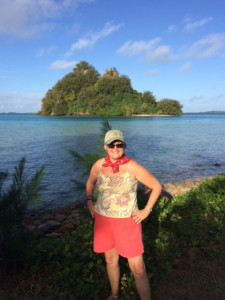Lynn Danaher Checks in from Polynesia
Posted May 10, 2015 at 11:29 am by Tim Dustrude
Lynn Danaher of the Friday Harbor Film Festival sends this update from half way across the Pacific Ocean…
Raivavae Research Program May 2015
One of the ways funds are generated to assist with the Friday Harbor Film Festival is by leading expeditions for an adventurous few to remote Polynesia. I took a small group to the Marquesas in 2012, that provided the essential seed money to launch the first Friday Harbor Film Festival in 2013. I am taking 2 small groups during May 2015 to a very remote island in Polynesia; Raivavae, Austral Islands.
The first time I arrived in 2006 to work with Edmundo Edwards and his daughter Alexandra, I did not believe that there was still a place in all of Polynesia that was as natural, unspoiled and stunningly beautiful as Raivavae. It is an island of remarkable simplicity with a population of almost 1,000.
Raivavae is one of 5 of the Austral Islands, lush, unspoiled and stunningly picturesque. It is located just south of the Tropic of Capricorn at 23*52’ S latitude and 147*40’ W longitude. The weather is ideal. It is a high island of eroded volcanic basalt, 5-7 million years old, surrounded by a fringing reef; the farthest south in French Polynesia, its numerous uninhabited Motus (small islands) create a beautiful shallow lagoon with varied hues of iridescent blues. It’s highest point; Mt. Hiro tops out at 1,423 feet.
Raivavae is an island with a very slow pace, where the people maintain a subsistence lifestyle; farming taro and fishing the outer reef in handmade outrigger canoes much like they have for generations. There are no restaurants, bars or tee-shirt shops, only a very few small pensions and small stores.
Tourists are still rare on Raivavae, all the local natives still offer an “Iorana” and a friendly wave each time we pass. We plan to attend the magnificent church in charming Anatonu village on Sunday to hear their specialized version of singing in harmony.
In the past, the people of Raivavae carved large stone statues and impressive altars with upright slab walled courts. These are the largest statues in Polynesia after those of Easter Island, and represent goddesses and deified ancestors of the different clans. Oral traditions mention that this flourishing culture formed part of an extensive trade network with its neighboring islands, including Easter Island.
We have been awarded The Explorers Club Flag to take into the field for this project. Our mission is to locate precisely the ancient sites with an advanced GPS. Confirm the directional orientation and the astronomical alignments. This is an important final piece of research as it relates to Edmundo’s and Alexandra’s recent book; When the Universe was an Island, www.universeisland.com.
Please follow our expedition on FB, Pacific Islands Research Institute. In 2016, we plan to take a small group to Easter Island.
Respectfully Submitted, Lynn Danaher
Pacific Islands Research Institute is a 501(c) 3 non-profit, and founding organization of the Friday Harbor Film Festival
You can support the San Juan Update by doing business with our loyal advertisers, and by making a one-time contribution or a recurring donation.
Categories: Around Here











No comments yet. Be the first!
By submitting a comment you grant the San Juan Update a perpetual license to reproduce your words and name/web site in attribution. Inappropriate, irrelevant and contentious comments may not be published at an admin's discretion. Your email is used for verification purposes only, it will never be shared.